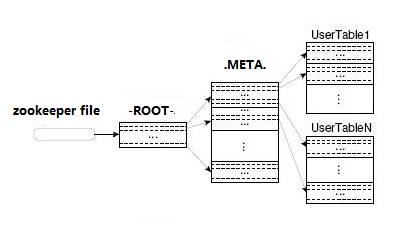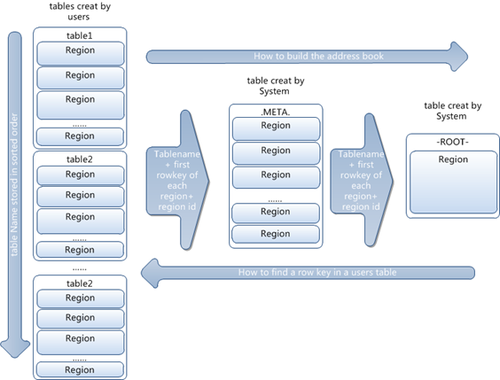RegionSplitter
java.lang.Objectorg.apache.hadoop.hbase.util.RegionSplitter
HBase写记录过程中regionname查找简介:主要是看如何进行region选择,完成按domain域的数据散列,分摊至不同region上
|-->HTable table = new HTable(config, tablename);
|-->Put put = new Put(Bytes.toBytes("test2"));
|-->put.add(Bytes.toBytes(cfs[j]), Bytes.toBytes(String.valueOf(1)), Bytes.toBytes("value_3"));
|-->table.put(put);
HTable-->put() |利用HTable管理记录
|-->doPut(Arrays.asList(put));
|-->for (Put put : puts)
|-->writeBuffer.add(put);
|-->if (n % DOPUT_WB_CHECK == 0 && currentWriteBufferSize > writeBufferSize)
|-->flushCommits();
|-->if (autoFlush || currentWriteBufferSize > writeBufferSize)
|-->flushCommits();
HTable-->flushCommits() |提交添加的记录,内存阀值可控制
|-->Object[] results = new Object[writeBuffer.size()];
|-->this.connection.processBatch(writeBuffer, tableName, pool, results);
|-->finally
|-->for (int i = results.length - 1; i>=0; i--)
|-->if (results[i] instanceof Result)
|-->writeBuffer.remove(i);
HConnection--->processBatch() |HConnectionImplementation 批量处理
|-->processBatchCallback(list, tableName, pool, results, null)
|-->List<Row> workingList = new ArrayList<Row>(list);
|-->Map<HRegionLocation, MultiAction<R>> actionsByServer = new HashMap<HRegionLocation, MultiAction<R>>();
|-->for (int i = 0; i < workingList.size(); i++) |逐行处理Batch的每一行
|-->Row row = workingList.get(i);
|-->HRegionLocation loc = locateRegion(tableName, row.getRow(), true); |根据行获取对应的Region
|-->byte[] regionName = loc.getRegionInfo().getRegionName();
|-->MultiAction<R> actions = actionsByServer.get(loc);
|-->Action<R> action = new Action<R>(row, i);
|-->lastServers[i] = loc;
|-->actions.add(regionName, action);
|-->for (Entry<HRegionLocation, MultiAction<R>> e: actionsByServer.entrySet()) { |根据actionsByServer进行执行,执行过程在Callable中完成
futures.put(e.getKey(), pool.submit(createCallable(e.getKey(), e.getValue(), tableName)));}
|-->for (Entry<HRegionLocation, Future<MultiResponse>> responsePerServer : futures.entrySet()) |提交完成后,对future的返回对象进行处理
HConnectionImplementation--->locateRegion(final byte [] tableName,final byte [] row, boolean useCache)
|-->if (tableName == null || tableName.length == 0) |非空判断
|-->ensureZookeeperTrackers(); |ZK确认跟踪器
|-->if (Bytes.equals(tableName, HConstants.ROOT_TABLE_NAME)) |根据tableName判断为root,meta,还是一般类型表
|-->ServerName servername = this.rootRegionTracker.getRootRegionLocation(); |从zk获取root的regionserver
|-->return new HRegionLocation(HRegionInfo.ROOT_REGIONINFO, |从ZK中返回root表存储的位置,建立server连接,用于获取meta表信息
servername.getHostname(), servername.getPort());
|-->else if (Bytes.equals(tableName, HConstants.META_TABLE_NAME)) |从meta表中获取region的信息
|-->return locateRegionInMeta(HConstants.ROOT_TABLE_NAME, tableName, row,
useCache, metaRegionLock);
|-->else |此时从meta中获取信息
|-->return locateRegionInMeta(HConstants.META_TABLE_NAME, tableName, row,
useCache, userRegionLock);
HConnectionImplementation--->locateRegionInMeta() |获取真正的region的location信息
|-->if (useCache) |客户端获取时会做cache,保存Location信息
|-->location = getCachedLocation(tableName, row);
|-->byte [] metaKey = HRegionInfo.createRegionName(tableName, row, HConstants.NINES, false);
|-->metaLocation = locateRegion(parentTable, metaKey); |定位root/meta的region信息
|-->HRegionInterface server = getHRegionConnection(metaLocation.getHostname(), metaLocation.getPort());
|-->regionInfoRow = server.getClosestRowBefore( metaLocation.getRegionInfo().getRegionName(), metaKey,
HConstants.CATALOG_FAMILY);
|-->byte [] value = regionInfoRow.getValue(HConstants.CATALOG_FAMILY, HConstants.REGIONINFO_QUALIFIER);
|-->HRegionInfo regionInfo = (HRegionInfo) Writables.getWritable(value, new HRegionInfo());
|-->value = regionInfoRow.getValue(HConstants.CATALOG_FAMILY, HConstants.SERVER_QUALIFIER);
|-->location = new HRegionLocation(regionInfo, hostname, port); |通过regionInfo和对应的regionserver机器名确认Location
|-->cacheLocation(tableName, location);
|-->return location;
HRegionServer-->getClosestRowBefore() |用于寻找目标row最接近的行,在此用于meta表中寻找最近的regionname
|-->HRegion region = getRegion(regionName); |根据regionname获取对应的region信息
|-->Result r = region.getClosestRowBefore(row, family); |在region中寻找最近的row
|-->coprocessorHost.preGetClosestRowBefore(row, family, result) |coprocessorHost预处理
|-->checkRow(row, "getClosestRowBefore"); |确认合法性
|-->startRegionOperation(); |设置读写锁
|-->Store store = getStore(family); |
|-->KeyValue key = store.getRowKeyAtOrBefore(row); |获取最接近的row行,并返回KeyValue对象
|-->Get get = new Get(key.getRow());
|-->get.addFamily(family);
|-->result = get(get, null);
|-->coprocessorHost.postGetClosestRowBefore(row, family, result); |处理完成后的钩子程序
Store-->getRowKeyAtOrBefore() |获取具体的family对应的存储单元Store,每一个Store中存储一列簇
|-->KeyValue kv = new KeyValue(row, HConstants.LATEST_TIMESTAMP); |包装row为KeyValue对象值,用于比较
|-->GetClosestRowBeforeTracker state = new GetClosestRowBeforeTracker( |封装比较对象
this.comparator, kv, ttlToUse, this.region.getRegionInfo().isMetaRegion());
|-->this.lock.readLock().lock(); |设定读写锁
|-->this.memstore.getRowKeyAtOrBefore(state); |分别在meta和HFile中进行搜索
|-->for (StoreFile sf : Lists.reverse(storefiles))
|-->rowAtOrBeforeFromStoreFile(sf, state);
|-->return state.getCandidate();
HConnection-->createCallable(final HRegionLocation loc, final MultiAction<R> multi, final byte [] tableName) |创建处理线程
|-->call() |在call对象中生成新的ServerCallable处理线程
|-->ServerCallable<MultiResponse> callable = new ServerCallable<MultiResponse>(connection, tableName, null) {}
|-->call()
|-->return server.multi(multi); |转换为HRegionServer的multi()方法
|-->connect(boolean reload)
|-->server = connection.getHRegionConnection(loc.getHostname(), loc.getPort()); |确认为哪个RegionServer
在 HBase中,大部分的操作都是在RegionServer完成的,Client端想要插入,删除,查询数据都需要先找到相应的 RegionServer。什么叫相应的RegionServer?就是管理你要操作的那个Region的RegionServer。Client本身并 不知道哪个RegionServer管理哪个Region,那么它是如何找到相应的RegionServer的?本文就是在研究源码的基础上揭秘这个过 程。
在 前面的文章“HBase存储架构”中我们已经讨论了HBase基本的存储架构。在此基础上我们引入两个特殊的概念:-ROOT-和.META.。这是什 么?它们是HBase的两张内置表,从存储结构和操作方法的角度来说,它们和其他HBase的表没有任何区别,你可以认为这就是两张普通的表,对于普通表 的操作对它们都适用。它们与众不同的地方是HBase用它们来存贮一个重要的系统信息——Region的分布情况以及每个Region的详细信息。
好了,既然我们前面说到-ROOT-和.META.可以被看作是两张普通的表,那么它们和其他表一样就应该有自己的表结构。没错,它们有自己的表结构,并且这两张表的表结构是相同的,在分析源码之后我将这个表结构大致的画了出来:
我们来仔细分析一下这个结构,每条Row记录了一个Region的信息。
首 先是RowKey,RowKey由三部分组成:TableName, StartKey 和 TimeStamp。RowKey存储的内容我们又称之为Region的Name。哦,还记得吗?我们在前面的文章中提到的,用来存放Region的文件 夹的名字是RegionName的Hash值,因为RegionName可能包含某些非法字符。现在你应该知道为什么RegionName会包含非法字符 了吧,因为StartKey是被允许包含任何值的。将组成RowKey的三个部分用逗号连接就构成了整个RowKey,这里TimeStamp使用十进制
的数字字符串来表示的。这里有一个RowKey的例子:
Table1,RK10000,12345678
然 后是表中最主要的Family:info,info里面包含三个Column:regioninfo, server, serverstartcode。其中regioninfo就是Region的详细信息,包括StartKey, EndKey 以及每个Family的信息等等。server存储的就是管理这个Region的RegionServer的地址。
所以当Region被拆分、合并或者重新分配的时候,都需要来修改这张表的内容。
到目前为止我们已经学习了必须的背景知识,下面我们要正式开始介绍Client端寻找RegionServer的整个过程。我打算用一个假想的例子来学习这个过程,因此我先构建了假想的-ROOT-表和.META.表。
我 们先来看.META.表,假设HBase中只有两张用户表:Table1和Table2,Table1非常大,被划分成了很多Region,因此 在.META.表中有很多条Row用来记录这些Region。而Table2很小,只是被划分成了两个Region,因此在.META.中只有两条Row 用来记录。这个表的内容看上去是这个样子的:
.META.
现在假设我们要从Table2里面插寻一条RowKey是RK10000的数据。那么我们应该遵循以下步骤:
1. 从.META.表里面查询哪个Region包含这条数据。
2. 获取管理这个Region的RegionServer地址。
3. 连接这个RegionServer, 查到这条数据。
好, 我们先来第一步。问题是.META.也是一张普通的表,我们需要先知道哪个RegionServer管理了.META.表,怎么办?有一个方法,我们把管 理.META.表的RegionServer的地址放到ZooKeeper上面不久行了,这样大家都知道了谁在管理.META.。
貌 似问题解决了,但对于这个例子我们遇到了一个新问题。因为Table1实在太大了,它的Region实在太多了,.META.为了存储这些Region信 息,花费了大量的空间,自己也需要划分成多个Region。这就意味着可能有多个RegionServer在管理.META.。怎么办?在 ZooKeeper里面存储所有管理.META.的RegionServer地址让Client自己去遍历?HBase并不是这么做的。
HBase的做法是用另外一个表来记录.META.的Region信息,就和.META.记录用户表的Region信息一模一样。这个表就是-ROOT-表。这也解释了为什么-ROOT-和.META.拥有相同的表结构,因为他们的原理是一模一样的。
假设.META.表被分成了两个Region,那么-ROOT-的内容看上去大概是这个样子的:
-ROOT-


这么一来Client端就需要先去访问-ROOT-表。所以需要知道管理-ROOT-表的RegionServer的地址。这个地址被存在ZooKeeper中。默认的路径是:
/hbase/root-region-server
等等,如果-ROOT-表太大了,要被分成多个Region怎么办?嘿嘿,HBase认为-ROOT-表不会大到那个程度,因此-ROOT-只会有一个Region,这个Region的信息也是被存在HBase内部的。
现在让我们从头来过,我们要查询Table2中RowKey是RK10000的数据。整个路由过程的主要代码在org.apache.hadoop.hbase.client.HConnectionManager.TableServers中:
private HRegionLocation locateRegion(final byte [] tableName,
final byte [] row, boolean useCache)
throws IOException{
if (tableName == null || tableName.length == 0) {
throw new IllegalArgumentException(
“table name cannot be null or zero length”);
}
if (Bytes.equals(tableName, ROOT_TABLE_NAME)) {
synchronized (rootRegionLock) {
// This block guards against two threads trying to find the root
// region at the same time. One will go do the find while the
// second waits. The second thread will not do find.
if (!useCache || rootRegionLocation == null) {
this.rootRegionLocation = locateRootRegion();
}
return this.rootRegionLocation;
}
} else if (Bytes.equals(tableName, META_TABLE_NAME)) {
return locateRegionInMeta(ROOT_TABLE_NAME, tableName, row, useCache,
metaRegionLock);
} else {
// Region not in the cache – have to go to the meta RS
return locateRegionInMeta(META_TABLE_NAME, tableName, row, useCache, userRegionLock);
}
}
这是一个递归调用的过程:
获取Table2,RowKey为RK10000的RegionServer
=>
获取.META.,RowKey为Table2,RK10000, 99999999999999的RegionServer
=>
获取-ROOT-,RowKey为.META.,Table2,RK10000,99999999999999,99999999999999的RegionServer
=>
获取-ROOT-的RegionServer
=>
从ZooKeeper得到-ROOT-的RegionServer
=>
从-ROOT-表中查到RowKey最接近(小于)
.META.,Table2,RK10000,99999999999999,99999999999999的一条Row,并得到.META.的RegionServer
=>
从.META.表中查到RowKey最接近(小于)Table2,RK10000, 99999999999999的一条Row,并得到Table2的RegionServer
=>
从Table2中查到RK10000的Row
到此为止Client完成了路由RegionServer的整个过程,在整个过程中使用了添加“99999999999999”后缀并查找最接近(小于)RowKey的方法。对于这个方法大家可以仔细揣摩一下,并不是很难理解。
最后要提醒大家注意两件事情:
- 在整个路由过程中并没有涉及到MasterServer,也就是说HBase日常的数据操作并不需要MasterServer,不会造成MasterServer的负担。
- Client端并不会每次数据操作都做这整个路由过程,很多数据都会被Cache起来。至于如何Cache,则不在本文的讨论范围之内。


